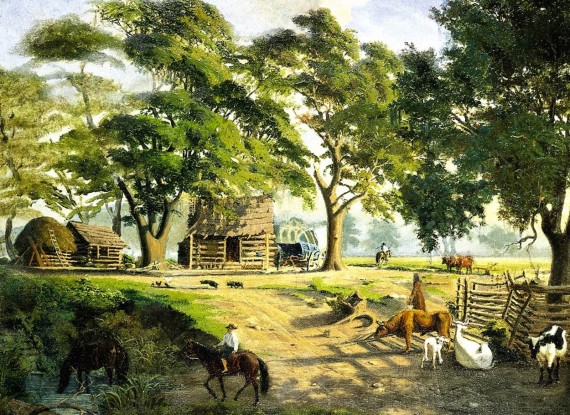on Driskill Hill, north Louisiana
“Throw out the radio and take down
the fiddle from the wall”
Andrew Lytle, “The Hind Tit”
I’ll Take My Stand (1930)
for fellow southern poet Jim Kibler
When daylight ends and silence minds the fields
Of stars and corn, late summer’s bumper yields,
I work, building a fiddle true and good,
Wood shorn from mountains dense with fiddle-wood.
And for those first stern turners of the land,
Raisers of barns by common tool and hand
I tune this Devil’s Box our preachers damn,
Praising in song all that I was and am:
Maple and spruce from driest altitudes,
Strips bitten by that crafter who concludes
Which flitch is best by touch and tooth alone,
Seasoned long years for quality of tone;
Designed then both by knowledge and by notions,
Pythagoras’s spiraling proportions,
God’s holy logarithms deep inlaid
In every part the fiddle-builder made,
In rib and back, in sound post, joint, and scroll
Where many disciplines inform the whole,
Philosophy, mathematics, chemistry,
Aesthetics, architecture, forestry.
And from such fields a measured resonance
Climbs vibrant in release like rhyme that once
Brought to each mountaintop or farm below
The music of the spheres all souls would know.
So on this north Louisiana hill,
The highest in the state, I’ll sing until
Winds thrill a lyre of pines they play upon
Like cedars on the peaks of Lebanon
Of English, Friendship, Lucky, Hunt, Saline,
Mount Olive, Loe, Mount Jordan, Friendship seen
Or dreamed from Welsh to Canterbury Road,
Old uplands rivers sculpted as they flowed,
Wolds in the yellow-pine-and-Bible belt,
Louisiana’s backbone on which dwelt
Twelve thousand years those Indians whose tongue
Is left for good and ever there among
Fossils of olives, whales, whole species lost
In ten millennia of sun and frost,
This northern borne of cracklin’s, black-eyed peas,
Mustard-green pot licker sopped to the lees,
Bowls baked from local clay, shoes sewn from hides
Of beasts we’ll kill and eat while time abides
Or that hot southern semi-tropic realm
Of marsh and swamp hurricanes overwhelm
So far from Driskill Hill where I may stay
In body though in spirit well away
Ranging through change and stasis as I go,
A poet-farmer footing row on row
Through spring’s grand dandelions, great summer suns,
Fall’s goldenrod, those open winter runs
Of deer and squirrel and cracking light on ice,
These ancient words in numbers that suffice
As must this table-catalogue of lines
Now listed here, each title that defines
Hard turnings of turned furrows, deep-plowed verse
Where things of time are saved from time’s first curse:
A north Louisiana church aflame,
Summers ending in winters whence they came,
A boy swimming to clutch a father’s hand,
Noah’s raven over a sunken land,
A farmer’s almanac and first estate,
A re-enactor come too soon, too late,
A daughter dying in her father’s arms,
Life leaving love untouched by prayers and charms,
A girl who walks the beaches of Grand Isle,
An overseer, a sniper that beguile
The mind with post- or antebellum days,
Agrarians still rebels in their ways:
All these and more a fiddle brings to us,
Its bow’s horsehairs the hairs of Pegasus.
So here on Driskill Hill I’ll stand and play
Bridging the riven shores of night and day
At day’s quiet end when barn-dance callers call
And fiddlers take their fiddles from the wall.






